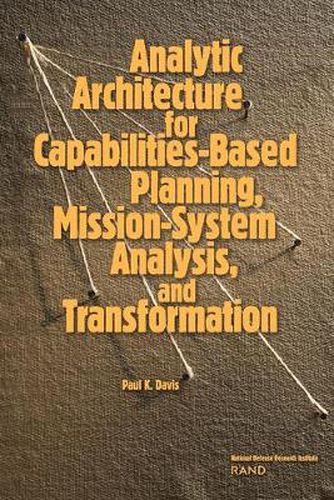Readings Newsletter
Become a Readings Member to make your shopping experience even easier.
Sign in or sign up for free!
You’re not far away from qualifying for FREE standard shipping within Australia
You’ve qualified for FREE standard shipping within Australia
The cart is loading…






Provides a definition of capabilities-based planning, puts it in the larger context of defense activities generally, and sketches an analytic architecture for carrying it out. Capabilities-based planning has become a central theme of defense planning. It is defined in broad terms in the 2001 Quadrennial Defense Review, but opinions differ about its details and how to implement it. This book reviews and extends ideas developed over the last decade regarding capabilities-based planning. It puts capabilities-based planning in the larger context of defense activities generally, sketches an analytic architecture for carrying it out, and offers recommendations about how to proceed, including a suggested architecture that emphasizes mission-level work and such concepts as mission-system analysis, exploratory analysis, and hierarchical portfolio methods for integration and tradeoffs in an economical framework. Capabilities-based planning is related to the objective of transforming U.S. forces to deal effectively with the changes taking place in military affairs. The book also emphasizes that the new paradigm of capabilities-based planning is particularly apt given the objective of transforming U.S. forces to deal effectively with the changes taking place in military affairs.
$9.00 standard shipping within Australia
FREE standard shipping within Australia for orders over $100.00
Express & International shipping calculated at checkout
Provides a definition of capabilities-based planning, puts it in the larger context of defense activities generally, and sketches an analytic architecture for carrying it out. Capabilities-based planning has become a central theme of defense planning. It is defined in broad terms in the 2001 Quadrennial Defense Review, but opinions differ about its details and how to implement it. This book reviews and extends ideas developed over the last decade regarding capabilities-based planning. It puts capabilities-based planning in the larger context of defense activities generally, sketches an analytic architecture for carrying it out, and offers recommendations about how to proceed, including a suggested architecture that emphasizes mission-level work and such concepts as mission-system analysis, exploratory analysis, and hierarchical portfolio methods for integration and tradeoffs in an economical framework. Capabilities-based planning is related to the objective of transforming U.S. forces to deal effectively with the changes taking place in military affairs. The book also emphasizes that the new paradigm of capabilities-based planning is particularly apt given the objective of transforming U.S. forces to deal effectively with the changes taking place in military affairs.